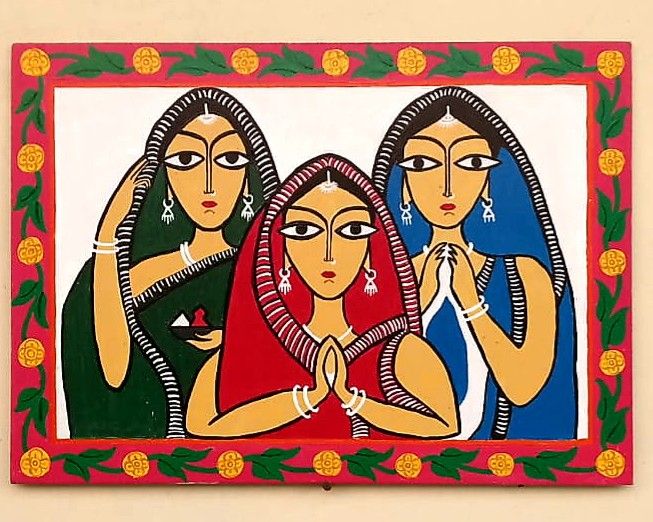Kalighat Painting: The Art of Bengal’s Storytellers

Art has always been a way to tell stories, express emotions, and capture traditions. Among India’s many traditional art forms, Kalighat painting stands out as a unique and bold style that emerged in 19th-century Bengal. Originating near the famous Kalighat Temple in Kolkata, this art form transformed from simple religious paintings to a powerful medium of social storytelling. Let’s dive into the vibrant world of Kalighat paintings!
Origins of Kalighat Painting
The Kalighat style was developed by a group of rural artists called patuas, who migrated to Kolkata from Bengal’s villages in the early 19th century. These artists used their skills to create paintings for pilgrims visiting the Kalighat Temple, one of the most sacred places for devotees of Goddess Kali.
At first, these paintings depicted Hindu gods and goddesses, but as time passed, Kalighat artists started illustrating everyday life, social issues, and political events. This shift made Kalighat paintings more than just religious souvenirs—they became a reflection of society.
What Makes Kalighat Paintings Unique?
Kalighat paintings are known for their bold, simple, yet expressive style. Here’s what makes them special:
1. Bold and Fluid Brushstrokes
Unlike many Indian art forms that use intricate details, Kalighat paintings are known for their bold outlines and smooth, flowing curves. The brushstrokes give a sense of movement, making the figures come alive.
2. Bright, Natural Colors
Artists originally used natural dyes and colors made from vegetables, flowers, and minerals. Common colors included:
- Red (from sindoor or vermillion)
- Blue (from indigo)
- Yellow (from turmeric)
- Black (from soot or charcoal)
Today, modern Kalighat artists use commercial paints, but the vibrancy remains the same.
3. Flat, Minimal Backgrounds
Kalighat paintings usually have a plain or lightly shaded background, which makes the main figure stand out. This is different from other Indian art styles, which often include detailed landscapes or decorative borders.
4. Themes That Tell a Story
Kalighat art is not just about beauty—it tells powerful stories. The themes can be divided into three main categories:
a) Mythological Themes
Many early Kalighat paintings depicted Hindu gods and goddesses, such as:
- Goddess Kali – The fierce mother goddess
- Lord Shiva – The destroyer and protector
- Krishna and Radha – The divine lovers
- Durga slaying Mahishasura – A symbol of good defeating evil
b) Social and Political Themes
As Kolkata became a center of British rule, Kalighat artists started painting scenes that mocked British officials, corrupt priests, and greedy landlords. These paintings were a form of silent protest against colonial oppression.
c) Everyday Life and Satirical Art
One of the most interesting aspects of Kalighat painting is its humor. Artists often made fun of hypocrisy in society, painting scenes of:
- A rich man pretending to be religious but being greedy
- A husband and wife arguing over daily matters
- British officers shown in exaggerated, comical ways
These paintings connected with ordinary people, making them laugh while also making them think.
How Were Kalighat Paintings Made?
The process of making a Kalighat painting was simple yet artistic:
- A thin sheet of handmade paper was stretched onto a wooden board.
- A rough pencil sketch was made of the subject.
- Bold, flowing outlines were drawn using black ink or charcoal.
- Colors were filled in using natural dyes.
- A final layer of varnish was applied to give the painting a glossy look.
Artists worked in small teams—one person did the sketches, another painted, and a third added finishing touches.
The Decline and Revival of Kalighat Painting
By the early 20th century, Kalighat paintings started disappearing. With the rise of printing presses and mass-produced pictures, fewer people bought handmade paintings. As a result, the traditional patuas lost their livelihood.
However, in recent years, there has been a revival of interest in folk and tribal art. Museums, art schools, and collectors are bringing back the charm of Kalighat paintings, encouraging artists to continue this legacy. Today, you can find modern Kalighat-style paintings, digital artworks, and even fabric prints inspired by this beautiful tradition.